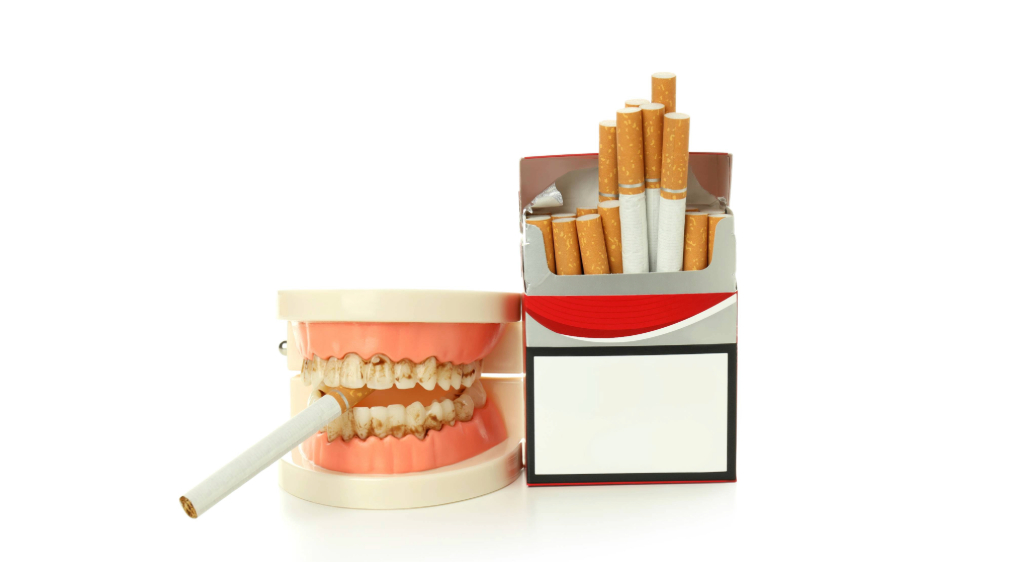Smoking and vaping affect a lot more than just your lungs.
These habits can wreak havoc on your oral health, causing everything from unsightly tartar buildup to serious periodontal disease.
As dentists and oral health specialists have observed for decades, tobacco users consistently face more dental health challenges than non-smokers.
When you smoke or vape, the chemicals in tobacco and e-liquids interact with your mouth’s natural environment, creating ideal conditions for tartar formation, gum inflammation, and a host of other dental problems.
While many smokers focus on yellowing teeth as their primary concern, the damage occurring beneath the gum line often goes unnoticed until it becomes serious.
In this comprehensive guide, we’ll explore exactly how smoking causes tartar buildup, what smoking can do to your teeth and gums over time, and whether alternatives like vaping offer any real benefits for your dental health.
We’ll also discuss what happens to your gums after quitting smoking and how specialized products like TartarEnd® can help restore your oral health even after years of tobacco use.
How Smoking Causes Tartar Buildup
Cigarette smoking and vaping directly contribute to tartar formation through several mechanisms that affect your mouth’s natural balance:
Altered Saliva Production
Smoking reduces saliva flow in your mouth. This matters because saliva is your body’s natural defense against bacteria and plaque. With decreased saliva, bacteria thrive and plaque forms more rapidly on your teeth.
Accelerated Plaque Hardening
The chemicals in tobacco smoke accelerate how quickly soft plaque hardens into tartar (also called calculus).
While everyone develops some plaque, smokers experience faster mineralization of this bacterial film into hard tartar deposits.
Oxygen Deprivation
Smoking restricts blood flow to your gums by constricting blood vessels. This oxygen deprivation creates an environment where harmful bacteria responsible for tartar formation can flourish while beneficial bacteria struggle.
Below The Gumline Damage
Perhaps most concerning is how smoking contributes to tartar buildup below the gum line, where it’s both invisible and more destructive. This subgingival tartar creates pockets between teeth and gums that harbor bacteria, leading to more serious periodontal issues over time.
Unlike surface stains that might be visible, tartar buildup from smoking often progresses silently, with many smokers unaware of the accumulation until their dentist points it out during a cleaning.
By then, significant damage may already be underway, with tartar deposits firmly attached to tooth surfaces and extending beneath the gum line.
The Visible Effects of Smoking on Teeth
Smoking doesn’t just cause hidden tartar buildup, it creates several immediately noticeable effects on your teeth:
Tooth Discoloration
The most obvious effect of smoking is yellowing or browning of teeth. Nicotine and tar in tobacco cling to dental enamel, creating stubborn stains that regular brushing cannot remove. Long-term smokers often develop deeply ingrained discoloration that may require professional whitening treatments.
Increased Cavities
Studies show smokers experience more dental cavities than non-smokers. This happens because smoking weakens tooth enamel and creates an acidic environment in the mouth, making teeth more vulnerable to decay. The combination of reduced saliva flow and increased bacterial activity creates perfect conditions for cavity formation.
Decreased Taste & Smell
Smoking damages taste buds and sensory abilities, dulling your ability to taste food. Many smokers compensate by adding more sugar and salt to their food, which further contributes to dental problems and decay.
Surface Texture Changes
Over time, smoking can actually change how your teeth feel. Smokers often develop rougher tooth surfaces as micro-abrasions from tar and chemicals create tiny pits in dental enamel. This rougher texture makes it easier for new plaque and stains to attach to the teeth.
These visible effects not only impact appearance but also serve as warning signs of the more serious damage occurring beneath the surface.
While aesthetic concerns often motivate smokers to improve their oral care, addressing the underlying tartar buildup is essential for true dental health
Smoking & Periodontal Disease
Beyond cosmetic concerns, smoking is a major risk factor for periodontal (gum) disease, one of the leading causes of tooth loss in adults. The connection between smoking and gum disease is so strong that smokers are up to six times more likely to develop periodontal problems than non-smokers.
How Smoking Triggers Gum Disease
Smoking affects your gums in several harmful ways:
- Weakened Immune Response: Tobacco chemicals suppress your body’s immune function, making it harder to fight off gum infections. This means minor gum problems can quickly escalate into serious conditions.
- Reduced Blood Flow: Smoking constricts blood vessels throughout your body, including those that supply your gums. With less blood flow, your gum tissues receive fewer nutrients and less oxygen, slowing healing and making them more vulnerable to infection.
- Masked Warning Signs: Early gum disease typically causes redness, swelling, and bleeding—but smoking can hide these symptoms by reducing blood flow to the gums. Many smokers don’t notice gum disease until it’s advanced, delaying treatment.
- Deeper Periodontal Pockets: Smokers tend to develop deeper spaces between teeth and gums where bacteria thrive. These “pockets” allow infections to penetrate deeper into tissues, eventually reaching the bone that supports your teeth.
Progression from Gingivitis to Periodontitis
For smokers, gum disease often advances quickly through these stages:
- Gingivitis: The initial stage of gum disease, characterized by inflammation. While reversible in non-smokers with good oral hygiene, smokers often progress to more serious stages despite brushing and flossing.
- Early Periodontitis: As infection penetrates deeper, the gums begin to pull away from teeth, forming pockets that collect even more bacteria and tartar.
- Advanced Periodontitis: In this stage, the infection damages the bone supporting your teeth. Smokers reach this stage faster and experience more severe bone loss than non-smokers.
The combination of tartar buildup and compromised gum health creates a particularly destructive cycle for smokers, each problem worsens the other, accelerating damage to both teeth and supporting structures.
Prevention & Treatment, Protecting Your Dental Health
If you smoke or vape, your dental health requires extra attention. While quitting tobacco products provides the greatest benefit, these practical steps can help minimize damage and protect your oral health:
Enhanced Dental Hygiene for Smokers & Vapers
Specialized Toothpaste: Products like TartarEnd® are particularly valuable for smokers and vapers.
TartarEnd’s patented formula is specifically designed to target tartar buildup both above and below the gum line, precisely where smokers experience the most problematic accumulation.
Unlike regular toothpastes that primarily address surface cleaning, TartarEnd works to break down existing tartar deposits while preventing new formation.
Brushing Technique: Brush for a full two minutes, twice daily, using gentle circular motions. Pay special attention to the gumline where tartar tends to accumulate. Consider an electric toothbrush, which studies show can be more effective at removing plaque for tobacco users.
Interdental Cleaning: Flossing daily is non-negotiable for smokers and vapers. Tartar forms more quickly between teeth where your toothbrush can’t reach. Water flossers can provide additional benefits by flushing out bacteria from deeper periodontal pockets common in smokers.
Professional Care Recommendations
More Frequent Cleanings: While twice-yearly dental visits are standard, smokers and vapers should consider quarterly professional cleanings. This helps manage tartar buildup before it leads to periodontal problems.
Deep Cleaning When Necessary: If you already have signs of gum disease, your dentist may recommend scaling and root planing, a deeper cleaning that addresses tartar below the gum line. Using products like TartarEnd between these procedures can help maintain results longer.
Regular Screenings: Tobacco users have an elevated risk for oral cancers. Request comprehensive oral cancer screenings during dental visits.
Dietary Adjustments
Calcium-rich foods: Strengthen tooth enamel by consuming dairy products, leafy greens, and calcium-fortified foods.
Crunchy Fruits and Vegetables: Apples, carrots, and celery act as natural tooth cleaners and stimulate saliva production, which helps neutralize acid and wash away food particles.
Limited Acidic and Sugary Items: Smoking already creates an acidic mouth environment; avoid compounding this with acidic foods and beverages. Similarly, limit sugary treats that feed harmful bacteria.
Hydration Matters
Drink plenty of water throughout the day, especially after smoking or vaping, to help wash away toxins and maintain saliva production. Rinsing your mouth after each smoking session can help reduce immediate exposure to harmful chemicals.
By combining these preventive measures with specialized products like TartarEnd, you can significantly reduce the dental damage associated with smoking and vaping, maintaining better oral health even while using tobacco products, though quitting remains the ultimate goal for optimal dental wellness.
Protect Your Smile
Smoking and vaping significantly increase tartar buildup and gum disease risk, damaging your oral health both visibly and below the gum line. While quitting tobacco offers the best protection, enhanced dental care can help minimize these effects and preserve your smile.
Take Action Today!
Ready to fight tartar buildup caused by smoking or vaping?
Try our patented formula, specifically designed to target tartar above and below the gum line where smokers need it most.
Your dental health doesn’t have to be compromised by tobacco use…




